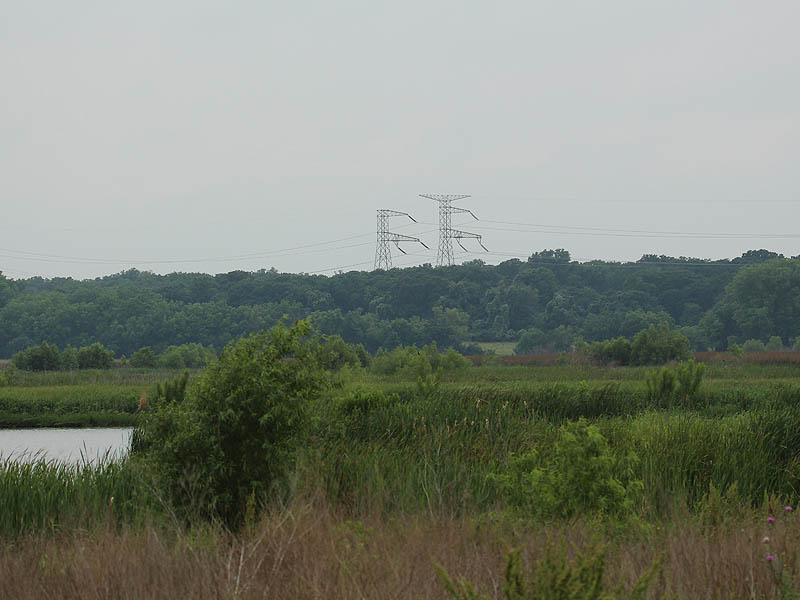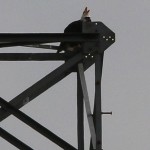NOTE: This post is part of a continuing series of observations: [ First | << Prev | Next >> ]
On Saturday May 25, 2013 I took my first picture ever of the transmission towers without eagles on them. The second eaglet fledged early last week, and now the nest is empty. From all indication this was a successful brood, but that may take some time—or even be impossible—to verify absolutely.

Because the eaglets are now hidden from view in the trees below the nest, following their progress on a regular basis will become much more difficult from this point forward. Once the young birds master flight, I expect that they will roam far and wide. As a consequence, this post likely marks my final update on the John Bunker Sands Bald Eagles for this year.


Now, then, is the time to reflect on what a truly remarkable circumstance this was. It is very possible these birds are the only breeding pair of Bald Eagles in the DFW Area. Even if there are others, these two birds must certainly be considered pioneers. You can probably count the number of resident Bald Eagles around Dallas/Fort Worth on one hand; the offspring from the nest at John Bunker Sands will be critical in re-establishing a nonmigratory population of eagles in this part of North Texas.
There is a great potential here for the species to expand its range back into its former territory, but that reclamation is far from a sure thing. There are major hurdles to overcome. Some from nature and some from man.
It takes Bald Eagles up to five years to reach breeding age. After that a mature breeding pair may require a couple of tries to have success. Instinct only takes Bald Eagles so far, there is some learning and experience required for these birds to master the art of raising young.
As I understand it, this pair of eagles has tried and failed on at least two other nesting attempts. Last year’s nest on this same tower failed some time after the eggs were laid, and it did not produce a successful brood. In the year prior to that, the eagles abandoned a nest building effort on a different transmission tower located a little further to the north, never even laying eggs.
What this means is that it took at least eight years for this pair of eagles to reach adulthood and raise a successful brood. Nearly a decade. This is typical of Bald Eagles and the same time frame for reproduction should be expected for any offspring these eagles produce. It may be 2021 before the eaglets from this year’s nest are able to raise a successful brood of their own. That’s a long way away.
It takes a lot of time and a big investment in effort and experience for Eagles to reproduce successfully. That’s part of what makes this breeding pair so special. They have figured it out.
The other part of the equation is the human factor. Bald Eagles have benefited in recent years from changes in attitudes about such things. Gone are the days when all birds of prey were viewed as chicken hawks to be exterminated. Today things are different. Most folks want to understand the value of nature and wildlife. Most people want to appreciate its worth. Most people know what is special about Bald Eagles.
These Bald Eagles are unquestionably a rare treasure and they belong to all of us. Going forward they will be depending on the wisdom of humans as much as anything for continued success. They will need to be facilitated by all practical means so that they are able to introduce as many new resident eagles into the system as possible.
As I pulled away from John Bunker Sands for the last time on Saturday it was hard to believe this project was over. At the exit, I glanced over my shoulder for a final look at the nest, and I noticed one of the adult eagles fly in from the east and land on one of the transmission towers. I quickly turned onto FM 1389 and pulled over in my favorite spot. I exited my car, and took a picture from roughly the same vantage point as the very first photograph I took of the eagle’s nest way back in early February.



So, that is how it is. Four months later, this project ends as it began—with a lone eagle overlooking an empty nest. Full-circle.

NOTE: This post is part of a continuing series of observations: [ First | << Prev | Next >> ]







I was there on Saturday also-arrived around 6:30am and waited 1 1/2 hour before the female arrived. She sat on the tower for over an hour, her constant plaintive cry was heartwrenching. No sign of either eaglet and I left while she was still atop the tower. There was a black vulture on one of the lower arms when I first arrived.
Well, Gay, I don’t believe we’ve seen the last of the juvenile eagles just yet. They are certainly still around, and certainly still begging to be fed, or the female would not be coming back to the nest site. The youngsters will need some time to develop as flyers. They may even make their way back up to the tower for a short while as soon as they can manage it. It is my understanding that the eaglets and their parents will roam about as a family group for most of the summer. If so, there will plenty of more chances to see the eagles… if you have the time to spend waiting for them to show!